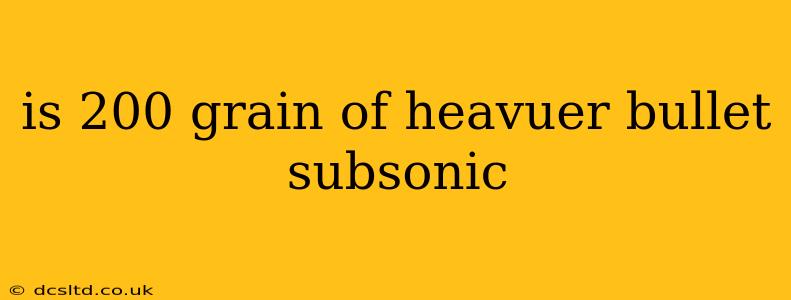Is a 200-Grain Bullet Subsonic?
The simple answer is: not necessarily. Whether a 200-grain bullet is subsonic depends entirely on the caliber, the powder charge, and the barrel length of the firearm. Let's break down why.
A subsonic bullet is one that travels slower than the speed of sound, which is approximately 1125 feet per second (fps) at sea level. The weight of the bullet (200 grains in this case) is only one factor influencing its velocity.
What Factors Determine if a 200-Grain Bullet is Subsonic?
-
Caliber: Larger calibers generally require more powder to propel a bullet to a given velocity. A 200-grain bullet in a .45 ACP will likely be subsonic with standard ammunition, while a 200-grain bullet in a much larger caliber, like a .338 Lapua Magnum, would be supersonic even with a reduced powder charge.
-
Powder Charge: The amount of propellant used directly impacts the bullet's velocity. A smaller powder charge will result in a slower bullet, increasing the likelihood of it being subsonic. Conversely, a larger charge will increase velocity. Ammunition manufacturers carefully tailor powder charges to achieve specific velocities for different applications.
-
Barrel Length: A longer barrel allows more time for the propellant to burn completely, transferring more energy to the bullet and increasing its velocity. Shorter barrels typically produce lower velocities. Therefore, a 200-grain bullet fired from a shorter barrel is more likely to be subsonic than one fired from a longer barrel.
How to Determine if Your Specific 200-Grain Ammunition is Subsonic?
The most reliable way to know if your specific 200-grain ammunition is subsonic is to check the manufacturer's specifications. This information is usually printed on the box or can be found on the manufacturer's website. Look for the bullet's velocity (measured in fps or m/s). If it's less than 1125 fps, it's subsonic.
What About Different Types of 200-Grain Bullets?
Different bullet designs, such as hollow points, full metal jackets, or match-grade bullets, can slightly influence velocity, but the caliber, powder charge, and barrel length remain the primary determinants. However, the bullet's design can influence its ballistic coefficient, affecting how well it retains velocity over distance.
Why Does it Matter if a Bullet is Subsonic?
Subsonic ammunition is often preferred for situations where minimizing noise is crucial, such as hunting or tactical operations. Supersonic bullets create a sonic boom, a characteristic "crack" that gives away the shooter's position. Subsonic ammunition also typically produces less recoil.
In conclusion, the weight of a bullet alone does not determine whether it's subsonic. Always refer to the manufacturer's specifications to determine the velocity of your specific ammunition.
